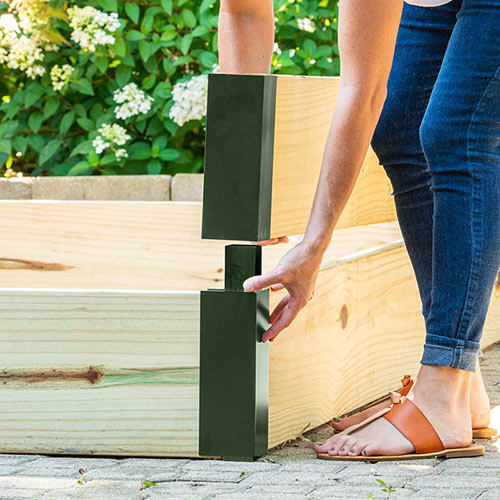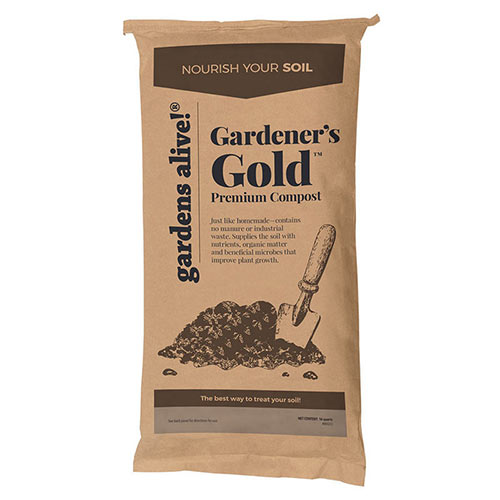Straw Bales: The Trend That Will Not Die!
-
Helpful Products from Gardens Alive!
-
 Raised Garden Bed Corners & Extenders
Raised Garden Bed Corners & Extenders -
 Gardener's Gold™ Premium Compost
Gardener's Gold™ Premium Compost
Several years back, a new "trend" appeared in the gardening world. Garden writers who long to have new material every week LOVE 'trends'; to me, they are about as useful as a tick bite. Remember upside-down tomato planters? Remember 'bag gardening', where you just slit open a bag of topsoil and plunk your plants into it? That short-lived 'trend' had the rare distinction of being less classy than planting in an old toilet bowl.
Like the American originator of the very concept of organic gardening, J. I. Rodale, I eschew trends and instead continually hammer away at the basics, like building raised beds, shunning pesticides, shredding fall leaves and improving the soil. (Kind of like a sign I once saw in a retro-themed thrift store that said, "new this week--NOTHING!")
You don't see many upside-down tomato planters anymore (thank The Good Earth) But this trend--'the straw bale trend'--keeps rising from the grave and shambling onto people's landscapes, no matter how many stakes I try and drive into its empty heart. I'm too cheap to try silver bullets, so let's go to the mailbag and find some fresh meat for your curmudgeon of gardening.
Q. Matt in "suburban Washington, D.C. (actually Chevy Chase, Maryland") writes: "I have some straw bales in my driveway that housed tomatoes over the summer. They're decomposing a bit but still have their shape. Can I plant my garlic into these bales? On one level, straw might be a great growing medium for garlic, but I worry about freezing. When the temps drop and we get a polar vortex or something, will the garlic survive?"
A. No, it will not survive, Matt; and then its spirit will return every Christmas Eve to rattle chains, taunt you and leave behind zucchinis the size of a ten-year-old child. Garlic is a 'root crop'; like Spring bulbs, garlic needs to be underground, surrounded by loose, light soil. While your straw IS admittedly loose and light, its nowhere near solid enough to even keep the cloves in place. And yes, once you get a couple of nights in the low thirties, those cloves will die a horrifying death, thanks to their being deprived of the insulation provided by soil. (Remember 'soil'? It's what we used to plant in!)
Ahem. Matt continues: "Relatedly, I just purchased a six-foot-long, 18-inch-high and 16-inch-wide galvanized steel, open-bottomed raised bed that I'm placing along one of the sunny side walls of my driveway. Would it make sense to fill it with soil, compost, and the straw bales and plant the garlic in there for the winter? Would that insulate the garlic?"
A. Yes, Matt--it would insulate the garlic. The pure carbon content of the straw, however, would also suck up all the available nitrogen (the primary food for root crops) and thus deliver to you something the final size of onion grass next summer. This is why we always warn people not to till shredded leaves or wood mulch into their beds. Such 'dry brown' materials will take years to decompose; and they'll be sucking the nitrogen out of that bed the whole time.
I do like your steel raised bed idea, however. Although technically above ground, it sounds large enough to insulate the cloves, especially with the added benefit of being located against a wall. Fill it with potting soil, compost, topsoil and some perlite and plant your garlic cloves closer to the center than the outside edge of the bed and you should be fine. (Always place bulbs, cloves and such more towards the center if the planter is above-ground in a region that gets winter weather.)
The bales? Make a scarecrow out of the straw and then feel free to use the straw to mulch the bed. That means on top; not inside.
Q. Ben in Boise writes: "will straw bales left in the bottoms of garden boxes go moldy over the winter? I just had some garden boxes installed and the guy that did it put straw bales in them so that we wouldn't have to add so much dirt. But now that it's getting cold, I'm wondering if the straw is going to get moldy over the winter and if I should wait for warmer weather to add the dirt.
A. When raised beds or containers are hugely ginormous (say two or three feet tall), it can be acceptable to add some type of material to the bottom. Rocks and stones are the best choice, as they will slowly release minerals into the mix. I used to think that those foam 'packing peanuts' were the worst choice, but by golly it seems I am never too old to be surprised.
Yes, straw will get nasty moldy in there. It will also get nasty moldy just sitting out in the open, but because of moisture, not cold. In a short growing season like yours, I would fill the beds immediately (that means now) with potting soil, topsoil, compost and perlite so you can hit the ground running next Spring. If the beds are only a foot to eighteen inches high, that's all you should fill them with. If they're taller, you can add a layer of stones on the bottom.
Use the straw for mulching the beds. But never ever mix nitrogen suckers like straw, wood or leaves INTO a bed or it will be useless for years.
Like the American originator of the very concept of organic gardening, J. I. Rodale, I eschew trends and instead continually hammer away at the basics, like building raised beds, shunning pesticides, shredding fall leaves and improving the soil. (Kind of like a sign I once saw in a retro-themed thrift store that said, "new this week--NOTHING!")
You don't see many upside-down tomato planters anymore (thank The Good Earth) But this trend--'the straw bale trend'--keeps rising from the grave and shambling onto people's landscapes, no matter how many stakes I try and drive into its empty heart. I'm too cheap to try silver bullets, so let's go to the mailbag and find some fresh meat for your curmudgeon of gardening.
Q. Matt in "suburban Washington, D.C. (actually Chevy Chase, Maryland") writes: "I have some straw bales in my driveway that housed tomatoes over the summer. They're decomposing a bit but still have their shape. Can I plant my garlic into these bales? On one level, straw might be a great growing medium for garlic, but I worry about freezing. When the temps drop and we get a polar vortex or something, will the garlic survive?"
A. No, it will not survive, Matt; and then its spirit will return every Christmas Eve to rattle chains, taunt you and leave behind zucchinis the size of a ten-year-old child. Garlic is a 'root crop'; like Spring bulbs, garlic needs to be underground, surrounded by loose, light soil. While your straw IS admittedly loose and light, its nowhere near solid enough to even keep the cloves in place. And yes, once you get a couple of nights in the low thirties, those cloves will die a horrifying death, thanks to their being deprived of the insulation provided by soil. (Remember 'soil'? It's what we used to plant in!)
Ahem. Matt continues: "Relatedly, I just purchased a six-foot-long, 18-inch-high and 16-inch-wide galvanized steel, open-bottomed raised bed that I'm placing along one of the sunny side walls of my driveway. Would it make sense to fill it with soil, compost, and the straw bales and plant the garlic in there for the winter? Would that insulate the garlic?"
A. Yes, Matt--it would insulate the garlic. The pure carbon content of the straw, however, would also suck up all the available nitrogen (the primary food for root crops) and thus deliver to you something the final size of onion grass next summer. This is why we always warn people not to till shredded leaves or wood mulch into their beds. Such 'dry brown' materials will take years to decompose; and they'll be sucking the nitrogen out of that bed the whole time.
I do like your steel raised bed idea, however. Although technically above ground, it sounds large enough to insulate the cloves, especially with the added benefit of being located against a wall. Fill it with potting soil, compost, topsoil and some perlite and plant your garlic cloves closer to the center than the outside edge of the bed and you should be fine. (Always place bulbs, cloves and such more towards the center if the planter is above-ground in a region that gets winter weather.)
The bales? Make a scarecrow out of the straw and then feel free to use the straw to mulch the bed. That means on top; not inside.
Q. Ben in Boise writes: "will straw bales left in the bottoms of garden boxes go moldy over the winter? I just had some garden boxes installed and the guy that did it put straw bales in them so that we wouldn't have to add so much dirt. But now that it's getting cold, I'm wondering if the straw is going to get moldy over the winter and if I should wait for warmer weather to add the dirt.
A. When raised beds or containers are hugely ginormous (say two or three feet tall), it can be acceptable to add some type of material to the bottom. Rocks and stones are the best choice, as they will slowly release minerals into the mix. I used to think that those foam 'packing peanuts' were the worst choice, but by golly it seems I am never too old to be surprised.
Yes, straw will get nasty moldy in there. It will also get nasty moldy just sitting out in the open, but because of moisture, not cold. In a short growing season like yours, I would fill the beds immediately (that means now) with potting soil, topsoil, compost and perlite so you can hit the ground running next Spring. If the beds are only a foot to eighteen inches high, that's all you should fill them with. If they're taller, you can add a layer of stones on the bottom.
Use the straw for mulching the beds. But never ever mix nitrogen suckers like straw, wood or leaves INTO a bed or it will be useless for years.
-
Helpful Products from Gardens Alive!
-
 Raised Garden Bed Corners & Extenders
Raised Garden Bed Corners & Extenders -
 Gardener's Gold™ Premium Compost
Gardener's Gold™ Premium Compost







 Gardens Alive! & Supplies
Gardens Alive! & Supplies




